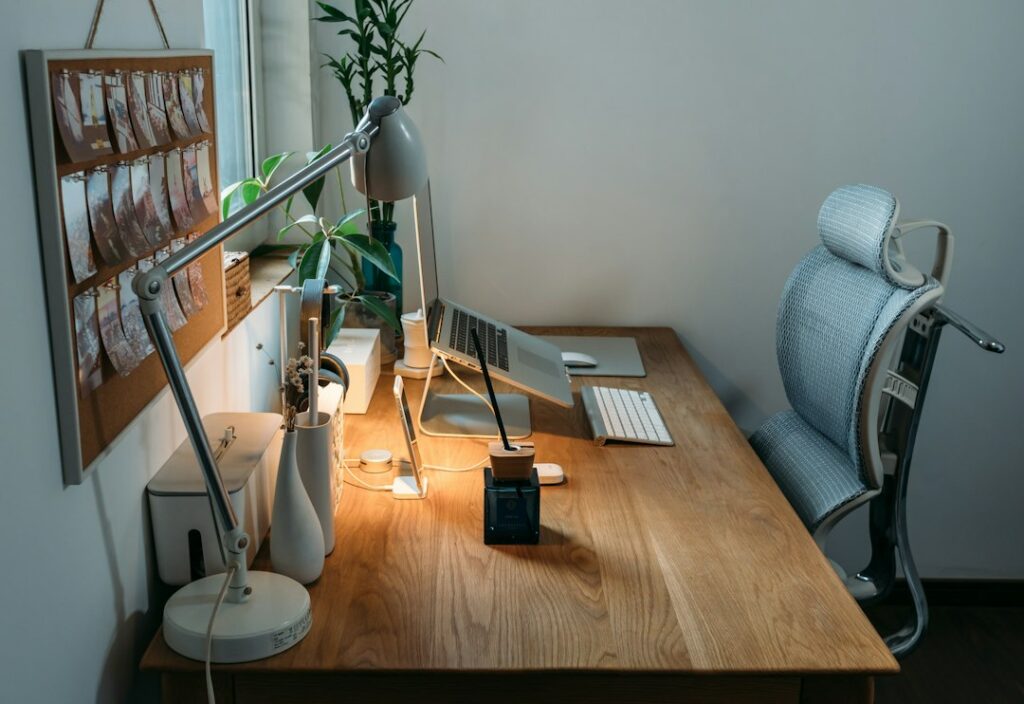In today’s digital age, more and more people are working from home. Whether you’re a freelancer, a remote worker, or someone who simply prefers to have a dedicated workspace in the comfort of your own home, having a comfortable and ergonomic home office chair is essential. A well-designed chair not only provides comfort and support, but it also plays a crucial role in maintaining good posture and reducing the risk of musculoskeletal disorders.
A poorly designed chair can have a significant impact on your health and productivity. Sitting for long periods in an uncomfortable chair can lead to back pain, neck strain, and other musculoskeletal issues. It can also cause fatigue and reduce your ability to concentrate and focus on your work. Therefore, investing in a high-quality home office chair that is designed with ergonomics in mind is crucial for your overall well-being.
Factors to Consider When Choosing a Home Office Chair
When choosing a home office chair, there are several factors to consider. First and foremost, adjustability and customization are key. Look for a chair that allows you to adjust the height, seat depth, armrests, and backrest angle to fit your body and posture. This will ensure that you can maintain a healthy sitting position throughout the day.
Materials and features also play an important role in chair design. Look for a chair that is made from high-quality materials that are durable and comfortable. Features such as lumbar support, adjustable headrests, and breathable upholstery can enhance your comfort and support while working.
Size and weight capacity are also important considerations. Make sure to choose a chair that is the right size for your body type and has a weight capacity that can accommodate your needs. A chair that is too small or too large can lead to discomfort and poor posture.
Understanding Ergonomics: Tips for a Healthy Posture
Ergonomics is the science of designing and arranging objects to fit the human body and promote efficiency and comfort. When it comes to sitting in a home office chair, ergonomics plays a crucial role in maintaining a healthy posture.
To maintain a healthy posture while sitting, it’s important to keep your feet flat on the floor or on a footrest, with your knees at a 90-degree angle. Your hips should be slightly higher than your knees, and your back should be supported by the chair’s backrest. Avoid slouching or leaning forward, as this can put strain on your back and neck.
Taking regular breaks and incorporating movement into your workday is also important for promoting good posture. Stand up, stretch, and walk around every hour or so to give your body a break from sitting. This will help prevent stiffness and muscle fatigue.
Designing Your Home Office: Ideas for a Productive Workspace Setup
Creating a well-designed workspace is essential for productivity. When setting up your home office, consider the layout and organization of your furniture and equipment.
Start by choosing a dedicated space for your home office that is separate from other areas of your home. This will help create a boundary between work and personal life. Make sure to have enough space for your desk, chair, and any other equipment you may need.
Organize your workspace in a way that promotes efficiency and minimizes distractions. Keep frequently used items within easy reach, and use storage solutions such as shelves, drawers, and filing cabinets to keep your workspace clutter-free.
Lighting and color also play a role in promoting focus and creativity. Natural light is ideal, so try to position your desk near a window if possible. If natural light is limited, invest in good quality task lighting to ensure adequate illumination. Choose colors that are calming and conducive to concentration, such as blues and greens.
Stylish Office Decor: How to Create a Professional and Inviting Atmosphere
The decor of your home office can have a significant impact on your mood and productivity. Creating a professional and inviting atmosphere can help you feel motivated and inspired to work.
Start by choosing a color scheme that reflects your personal style and promotes focus. Consider using neutral colors as a base, and add pops of color through accessories such as artwork, plants, or decorative items.
Personalization is also important in creating a comfortable and inspiring workspace. Display photos, artwork, or other items that are meaningful to you. This will help create a sense of ownership and make your workspace feel more inviting.
Invest in quality furniture and accessories that are both functional and aesthetically pleasing. Choose a desk that is the right size for your needs, and invest in a comfortable chair that matches your decor. Consider adding plants or other natural elements to bring life and freshness to your workspace.
The Benefits of an Ergonomic Home Office: Improved Health and Productivity

Creating an ergonomic home office has numerous benefits for both your health and productivity. A comfortable and supportive chair is essential for reducing pain and discomfort associated with sitting for long periods.
An ergonomic chair provides proper support to the spine, reducing the risk of back pain and other musculoskeletal disorders. It promotes good posture by aligning the spine, hips, and neck in a neutral position. This reduces strain on the muscles and ligaments, preventing fatigue and discomfort.
In addition to reducing pain and discomfort, an ergonomic home office can also improve productivity. When you’re comfortable and supported, you can focus better on your work without distractions. You’ll also have more energy and stamina to complete tasks efficiently.
Adjusting Your Chair for Optimal Comfort and Support
Once you have chosen an ergonomic home office chair, it’s important to adjust it properly for optimal comfort and support. Here are some tips for adjusting your chair to fit your body and posture:
– Start by adjusting the height of the chair so that your feet are flat on the floor or on a footrest, with your knees at a 90-degree angle.
– Adjust the seat depth so that there is a small gap between the back of your knees and the edge of the seat.
– Adjust the backrest angle to support the natural curve of your spine. The backrest should be slightly reclined, with your hips slightly higher than your knees.
– Adjust the armrests so that your elbows are at a 90-degree angle and your shoulders are relaxed.
– Use any additional features such as lumbar support or adjustable headrests to enhance your comfort and support.
Regularly adjusting your chair is important for maintaining a healthy and comfortable workspace. As you work, pay attention to any discomfort or strain and make adjustments as needed. This will ensure that you are always sitting in a position that promotes good posture and reduces the risk of pain and discomfort.
Home Office Organization: Tips for a Clutter-Free Workspace
A cluttered workspace can have a negative impact on productivity and focus. To create a clutter-free home office, consider the following tips:
– Start by decluttering your workspace. Remove any items that are not necessary for your work and find a designated place for them.
– Use storage solutions such as shelves, drawers, and filing cabinets to keep your workspace organized. Label items and create a system for easy retrieval.
– Keep frequently used items within easy reach. This will save you time and prevent distractions.
– Minimize paper clutter by going digital whenever possible. Scan documents and store them electronically to reduce the need for physical storage.
– Regularly clean and tidy your workspace to maintain a clutter-free environment. Set aside time each week to organize and declutter.
Maintaining a clutter-free workspace will not only improve productivity but also reduce stress and create a more inviting and inspiring atmosphere.
Choosing the Right Materials and Features for Your Home Office Chair
When choosing a home office chair, it’s important to consider the materials and features that will provide the most comfort and support for your needs.
The materials used in the chair can have a significant impact on comfort. Look for a chair that is made from high-quality materials that are durable and comfortable. Breathable upholstery can help regulate temperature and prevent sweating, while cushioning materials such as memory foam can provide extra support and comfort.
Features such as lumbar support, adjustable headrests, and armrests can enhance your comfort and support while working. Lumbar support helps maintain the natural curve of your spine, reducing strain on the lower back. Adjustable headrests provide support for your neck and head, reducing strain on the neck muscles. Armrests that are adjustable in height and width can help prevent shoulder and neck pain.
Customization is also important when choosing a home office chair. Look for a chair that allows you to adjust the height, seat depth, armrests, and backrest angle to fit your body and posture. This will ensure that you can maintain a healthy sitting position throughout the day.
Investing in Your Health and Comfort with an Ergonomic Home Office Chair
Investing in a comfortable and ergonomic home office chair is essential for your health and well-being. A well-designed chair not only provides comfort and support but also promotes good posture and reduces the risk of musculoskeletal disorders.
When choosing a home office chair, consider factors such as adjustability, materials, features, size, and weight capacity. These factors will ensure that you choose a chair that fits your body and posture and provides optimal comfort and support.
Creating an ergonomic home office has numerous benefits for both your health and productivity. A comfortable and supportive chair reduces pain and discomfort associated with sitting for long periods, while promoting good posture and reducing the risk of musculoskeletal disorders. This, in turn, improves focus, concentration, and overall productivity.
In addition to investing in a comfortable and ergonomic chair, consider designing your home office in a way that promotes efficiency and minimizes distractions. Organize your workspace, choose the right lighting and color scheme, and personalize your decor to create a professional and inviting atmosphere.
By investing in your health and comfort with an ergonomic home office chair, you are taking a proactive step towards creating a productive and enjoyable workspace. Your body will thank you, and your productivity will soar.
If you’re looking to create a comfortable and ergonomic home office chair, you might also be interested in this article on “Upcycling and DIY Furniture” from House Hack Tips. It provides creative ideas and step-by-step instructions on how to repurpose old furniture and materials to create unique and functional pieces for your home office. Check it out here!


